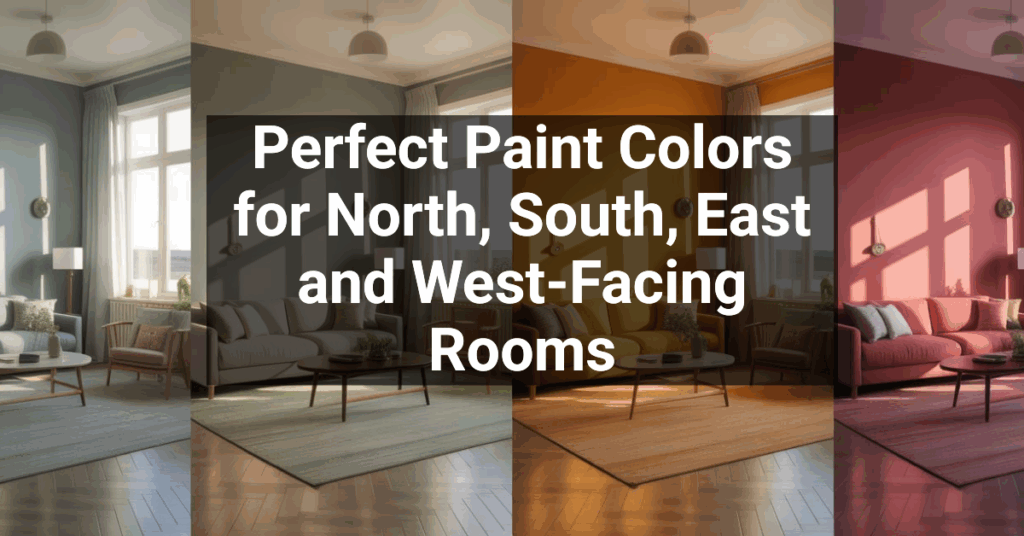Ever walk through a house where each room feels like it belongs to a totally different story? It’s unsettling, right? A home should flow from space to space, giving off a sense of harmony and intention.
Remember to repin your favorite images!
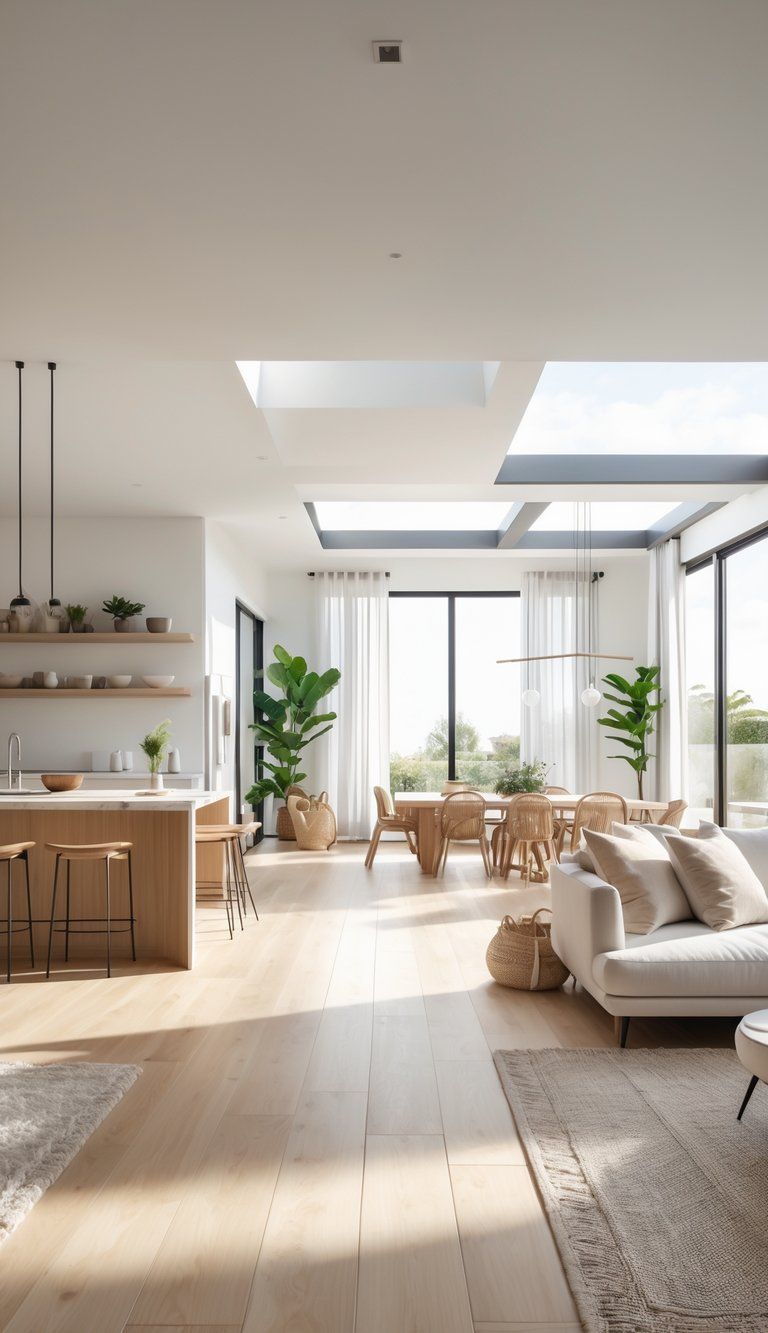
Seamless transitions between rooms instantly make your home feel bigger, calmer, and more thoughtfully designed. You don’t have to make every room a carbon copy of the last. The real trick is finding ways to connect spaces using consistent elements but still letting each area have its own vibe.
Think of it like a book—each room is a new chapter, but the story keeps building.
You can totally get this cohesive flow without gutting your whole house. Try using the same flooring, carrying colors from one room to another, or repeating a few key design elements. Even if your place is a work-in-progress, these choices help everything feel connected.
Understanding Cohesive Home Design
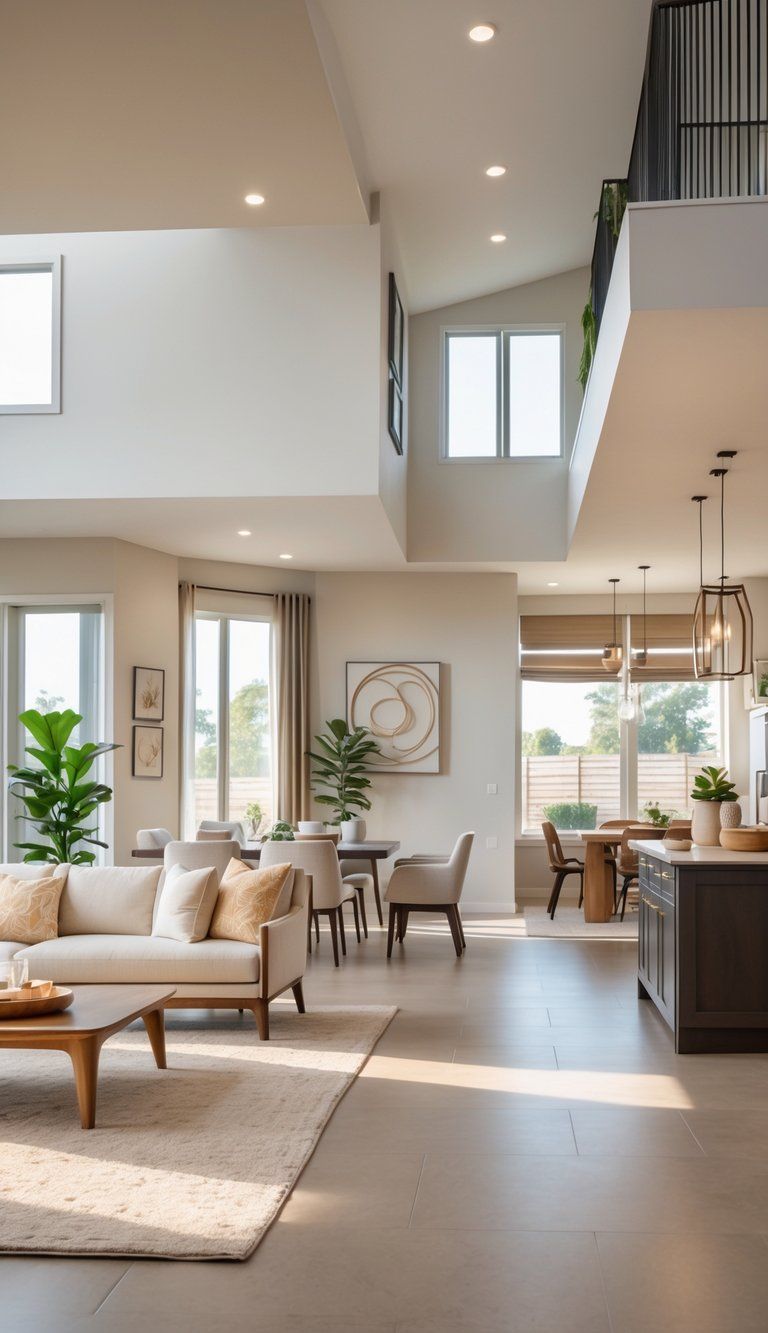
You don’t need every room to be a twin. A cohesive home just means everything feels like it belongs together, even if each space has its own personality.
A good design creates harmony but still lets each area serve its own purpose.
Defining Cohesion in Interior Design
Cohesion means your home feels connected and intentional, not random. Imagine telling one story throughout your house—with every room as a different chapter.
When you create cohesion, rooms just flow into each other. Colors, materials, and styles work together instead of fighting for attention.
Matching everything exactly? That gets boring fast.
Instead, cohesive design builds visual relationships between spaces. Maybe you use the same wood finish in a few rooms, or a favorite accent color keeps popping up.
The sweet spot is balance—enough unity to feel put-together, but enough variety to keep things interesting.
Importance of Visual Flow Between Rooms
Visual flow guides you through your home in a way that just feels right. When rooms connect smoothly, the whole place feels bigger and more welcoming.
If the flow isn’t there, things get choppy. You might notice a weird feeling when you step from one room into another that looks totally different.
Good flow makes your home feel peaceful and organized. Your eyes and brain don’t have to work so hard as you move around.
It also makes decorating less of a headache. Once you’ve set some core design rules, picking out new furniture or art gets way easier.
Key Design Principles for Seamless Transitions
Color continuity is huge. Choose a palette of three to five colors and use them throughout your home. Play with how much of each color you use in different rooms.
Consistent flooring really helps rooms blend together. If you can’t use the same material everywhere, pick floors with similar tones or textures.
Repeated elements pull everything together. Try things like:
- Similar lighting fixtures
- Matching door handles
- Consistent window treatments
- A material (maybe brass or marble) that pops up in each room
Sightlines make a big impact. Look at what you see from one room into the next. You want those views to feel connected, not jarring.
And don’t ignore those in-between spaces—hallways and doorways are perfect chances to tie everything together.
Establishing a Consistent Color Palette
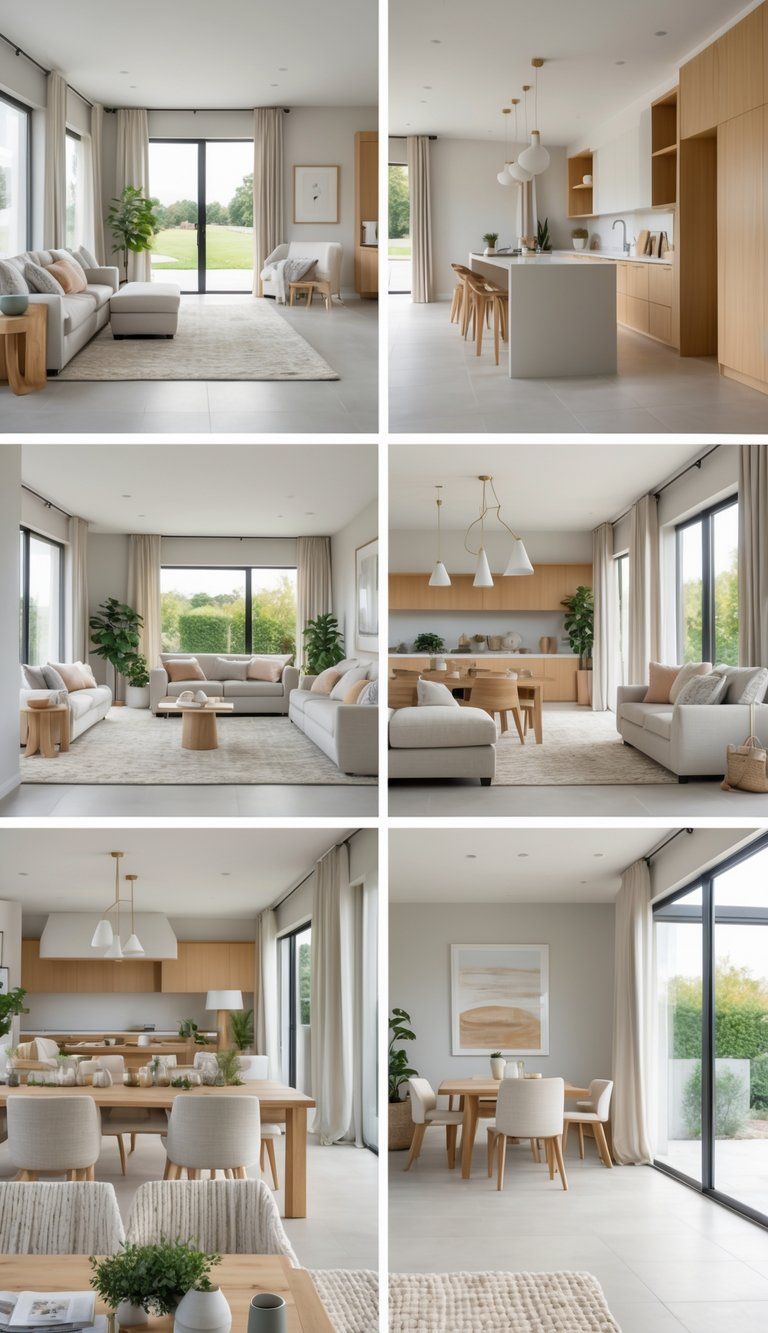
If you want rooms to flow, start with a smart color palette. Nailing your color scheme helps everything feel harmonious instead of random.
Choosing the Right Color Scheme
Pick a neutral base color that works everywhere. Designers call this a “flow-through paint”—it connects spaces, especially if you’ve got an open layout.
Good neutrals? Soft grays, warm beiges, or muted blues.
Add a few colors to each room that fit its purpose but still relate to the spaces next door. Maybe the kitchen gets a lively color, while the bedroom gets something calm.
Try the 60-30-10 rule: use your main color for most of the room, a secondary color for about a third, and an accent color for the finishing touches.
Consistency doesn’t mean everything’s the same color—just that the colors relate.
Using the Color Wheel to Guide Decisions
The color wheel is actually pretty useful here. Colors next to each other (analogous) give you a gentle flow. Opposite colors (complementary) add a bit of energy and contrast.
If you want to play it safe, stick to colors that sit next to each other—like blue and green.
For more pop, try complementary colors, but use them in different amounts in each room. Maybe a blue living room connects to a dining area with orange accents and just a hint of blue.
Think about color temperature, too. Warm colors and cool colors set different moods. Mixing them can work if the undertones match.
Repeating Colors for a Unified Look
Repetition is your friend. Pick three to five colors and use them throughout your home, but switch up which one is dominant.
Maybe your living room has a blue sofa, and then blue shows up in the dining room art or pillows.
Paint trim and doorways the same color everywhere. It helps your eye travel smoothly from space to space.
Try a “color thread”—one bold color that pops up in every room, like emerald green in pillows, frames, or small decor.
Patterns can help too. A multicolored rug in one room could inspire the palette for the next space.
Flooring and Transitions for Smooth Flow
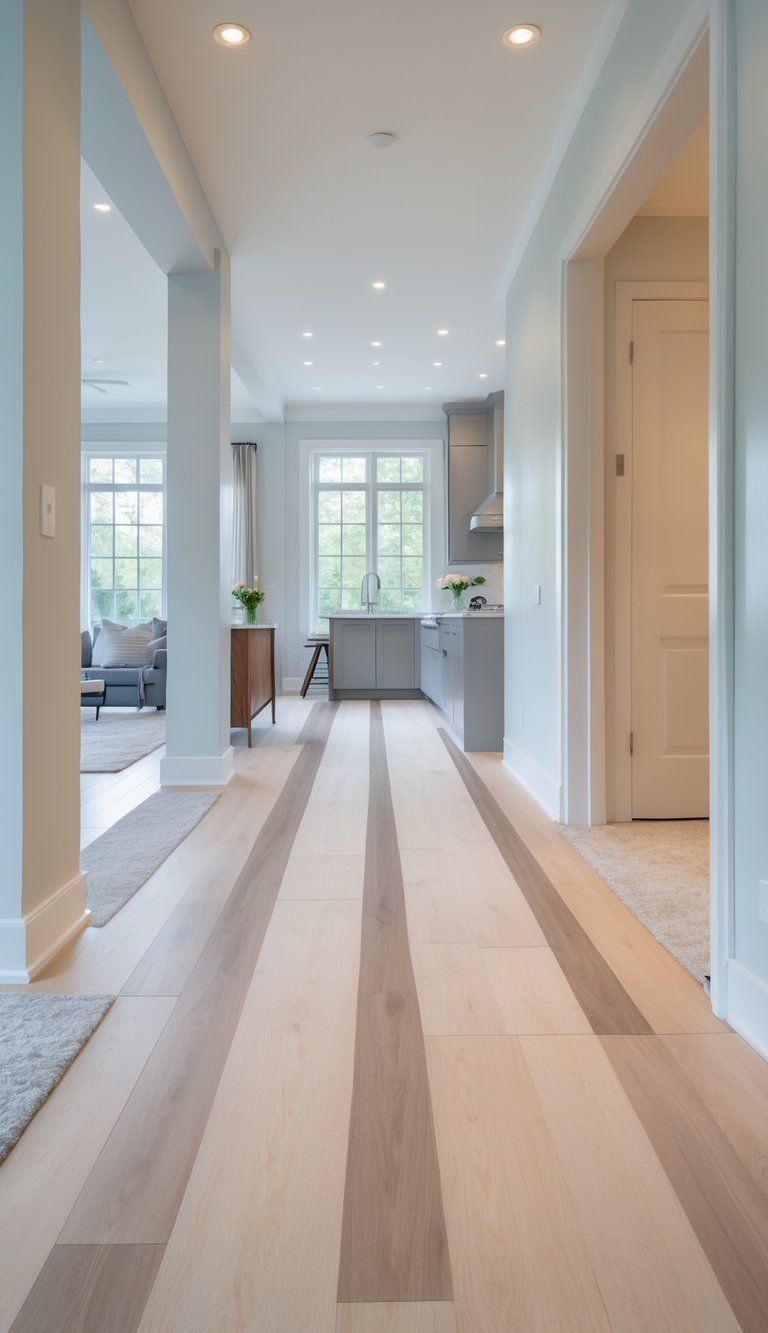
Flooring is a big deal for tying spaces together. The right floors create harmony and help people move naturally from room to room.
Benefits of Consistent Flooring Throughout
Using the same flooring everywhere gives your home an instant sense of unity. It also makes spaces feel bigger—especially in open layouts.
Consistent flooring removes awkward transitions and keeps things looking clean. Your eyes just glide across the space without hitting any weird breaks.
It makes cleaning easier too, since you’re dealing with just one type of floor. Hardwood, luxury vinyl, or big tiles are all solid choices for whole-home consistency.
Color matters here. Lighter floors usually make spaces feel more open, while darker ones add coziness and drama. Pick what fits your style.
Transition Materials for Different Spaces
If you need different floors in some areas, use smart transitions to avoid ugly breaks. T-moldings, threshold strips, and reducer strips help connect spots where the floor heights don’t match.
Metal transition strips look modern and work well between wood and tile. Want something more subtle? Match the strip to one of your floor materials.
Line up flooring changes with door thresholds. It makes the transition feel intentional.
Try gradual color shifts between spaces. Maybe go from lighter to darker wood tones as you move through the house—it helps guide the eye and feels more natural.
Strategic Use of Rugs and Area Rugs
Rugs do more than just add comfort. They define zones without breaking up your flooring visually.
In open spaces, use rugs to mark out conversation areas or dining spaces. Make sure the rug is big enough—either all the furniture sits on it, or all off, for a tidy look.
Layer rugs with similar colors to add depth but keep cohesion. This works great when you’re moving between spaces with different uses.
Runner rugs in hallways guide movement and protect high-traffic spots. They also help connect rooms with different floors.
Coordinating Furniture and Layout
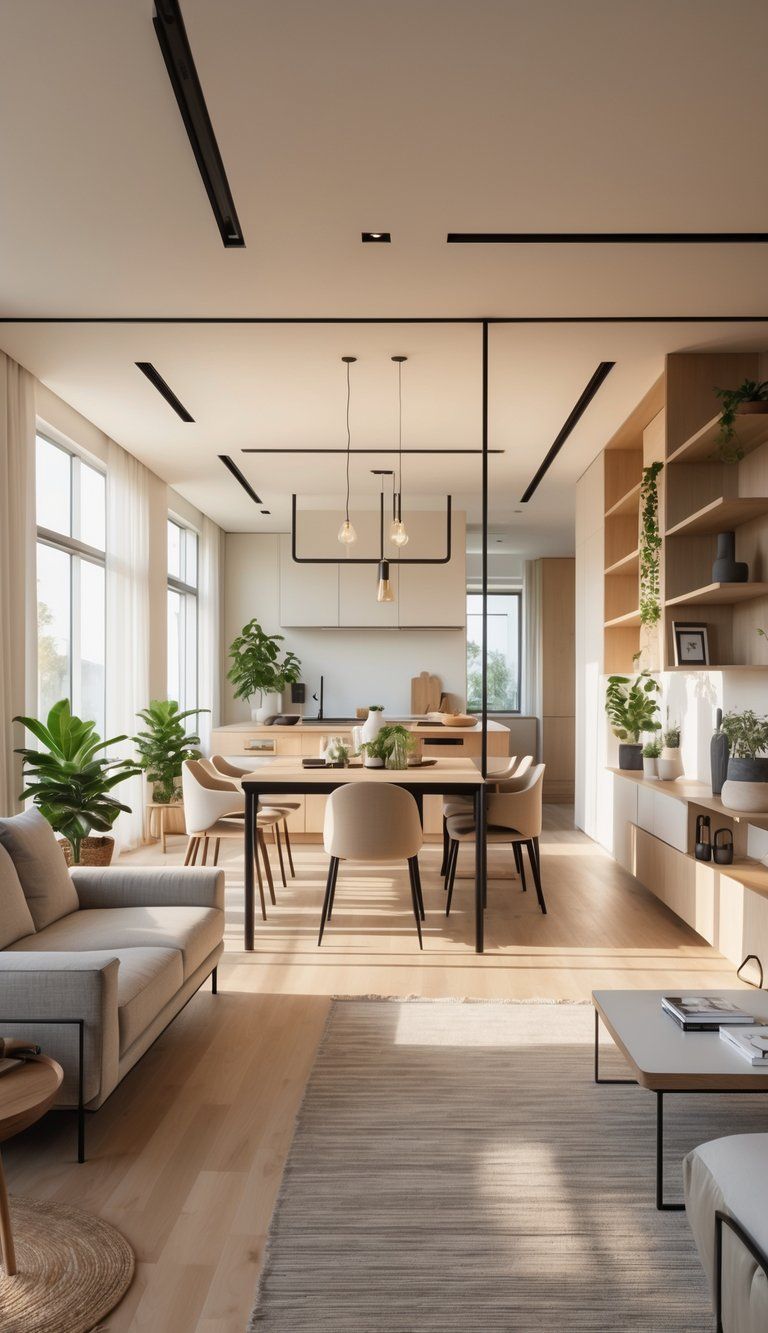
A unified look across rooms starts with furniture that makes sense together and thoughtful placement. The right pieces and arrangement can make your whole home feel intentional.
Harmonizing Furniture Style and Placement
Pick furniture with shared elements to link rooms visually. You don’t need to buy a matching set for every space. Instead, look for similar lines, materials, or styles.
Got mid-century modern chairs in the dining room? Maybe add a coffee table with the same slim legs in the living room. It’s a subtle connection that feels natural.
Pay attention to sight lines. Place key pieces so you can see them from adjoining rooms—this helps create a natural flow.
In open layouts, use furniture to mark out different zones, but keep the look cohesive.
Pro tip: Pick two or three signature elements (like wood tone, leg style, or fabric) and repeat them throughout your home.
Balancing Functionality and Flow
Arrange furniture so it fits how you actually live. Map out how people walk through the space before you decide where things go.
Leave about 30-36 inches for main walkways.
Connect rooms by:
- Aiming sofas and chairs to encourage conversation
- Keeping walkways clear between spaces
- Placing furniture to highlight cool features
In open homes, use rugs to define spaces, but keep their style consistent. A living room rug with colors from the kitchen can tie everything together.
Don’t crowd rooms with too much furniture. Negative space matters—it keeps things feeling open. For small spaces, go for multi-purpose pieces so you get more function without sacrificing style.
Design Elements That Connect Spaces
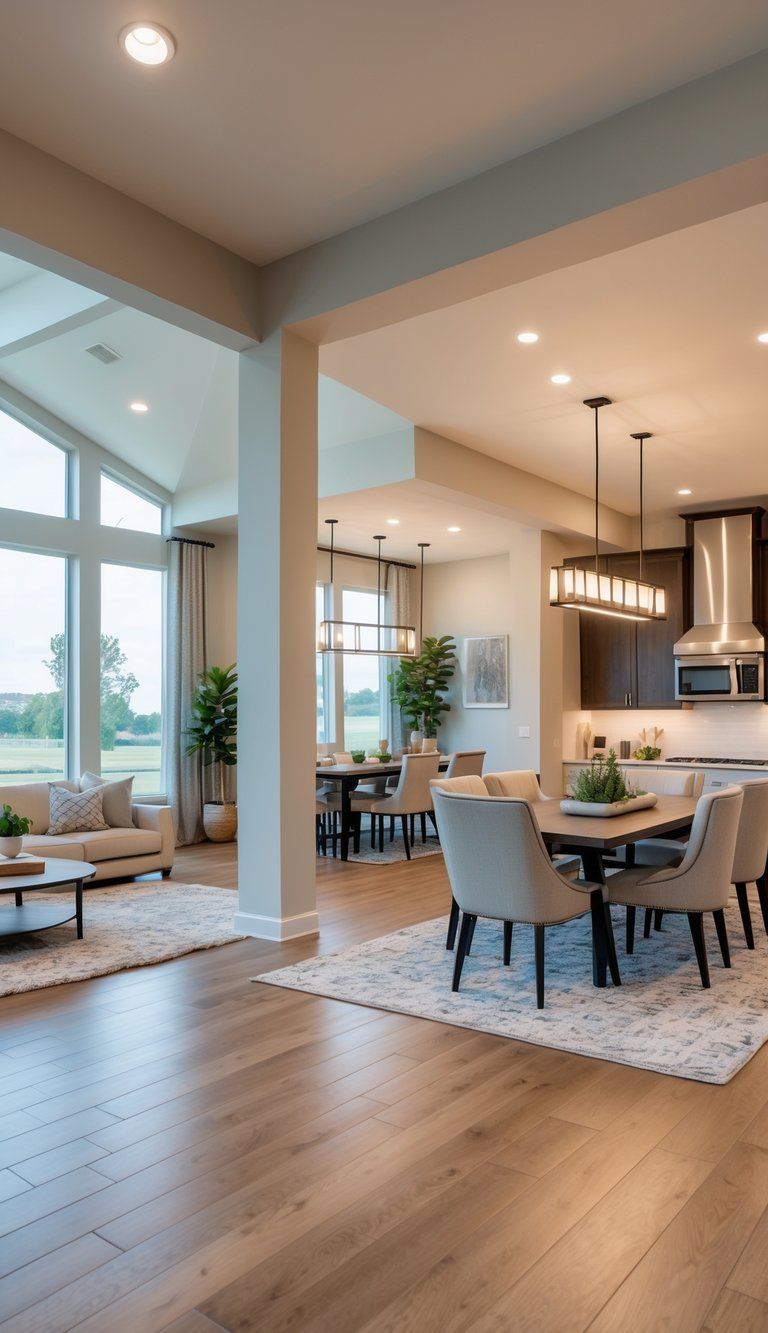
The right design elements really pull a home together. They bridge the gaps and help your whole house tell a single story.
Integrating Patterns and Textures
Patterns and textures work wonders for connecting rooms. Start by choosing two or three patterns you love and use them throughout—could be stripes, florals, or geometrics.
Mix up textures to add interest. Try pairing:
- Smooth with rough
- Matte with glossy
- Soft fabrics with hard surfaces
Scale matters. Use bigger patterns in larger rooms, smaller ones in cozier spaces. This keeps things consistent but lets each area shine.
When you bring in a new pattern, make sure it shares at least one color with your existing palette. That way, even bold patterns feel like they belong.
Textiles and Wood Tones for Coherence
Textiles make it so easy to tie rooms together without a full-blown makeover. You might toss in matching throw pillows, pick curtains with a shared pattern, or lay down area rugs in similar colors across different spaces.
That way, your eyes just kind of drift naturally from one room to the next.
Wood tones don’t have to match perfectly, but they should feel like they belong together. Here’s what usually works:
- Dominant wood tone: Pick one main finish for your big furniture pieces.
- Accent woods: Mix in one or two complementary tones for smaller stuff.
- Unifying elements: Stick with similar hardware finishes across all your wood pieces.
If you’re mixing wood tones, try to keep the undertones in the same family. Warm woods like cherry or mahogany seem to get along best with other warm tones. Cooler woods—think ash or certain maples—pair better with other cool-toned woods.
Repetition and Contrasts in Decor
Repeating a few decor elements can really set a rhythm in your home. Maybe you carry the same lamp style from room to room, or stick to one metal finish like brass or chrome.
Art with related themes or colors, or even matching plant containers, helps rooms feel connected.
But don’t go overboard. A little contrast keeps things interesting. Dark pieces stand out against light walls, and mixing smooth with textured surfaces adds some excitement.
Sometimes you just need a “surprise” piece—a bold accent that still fits your color scheme but makes you pause. Done right, contrast actually pulls your design together rather than making it feel scattered.
Lighting Strategies for Unified Ambiance
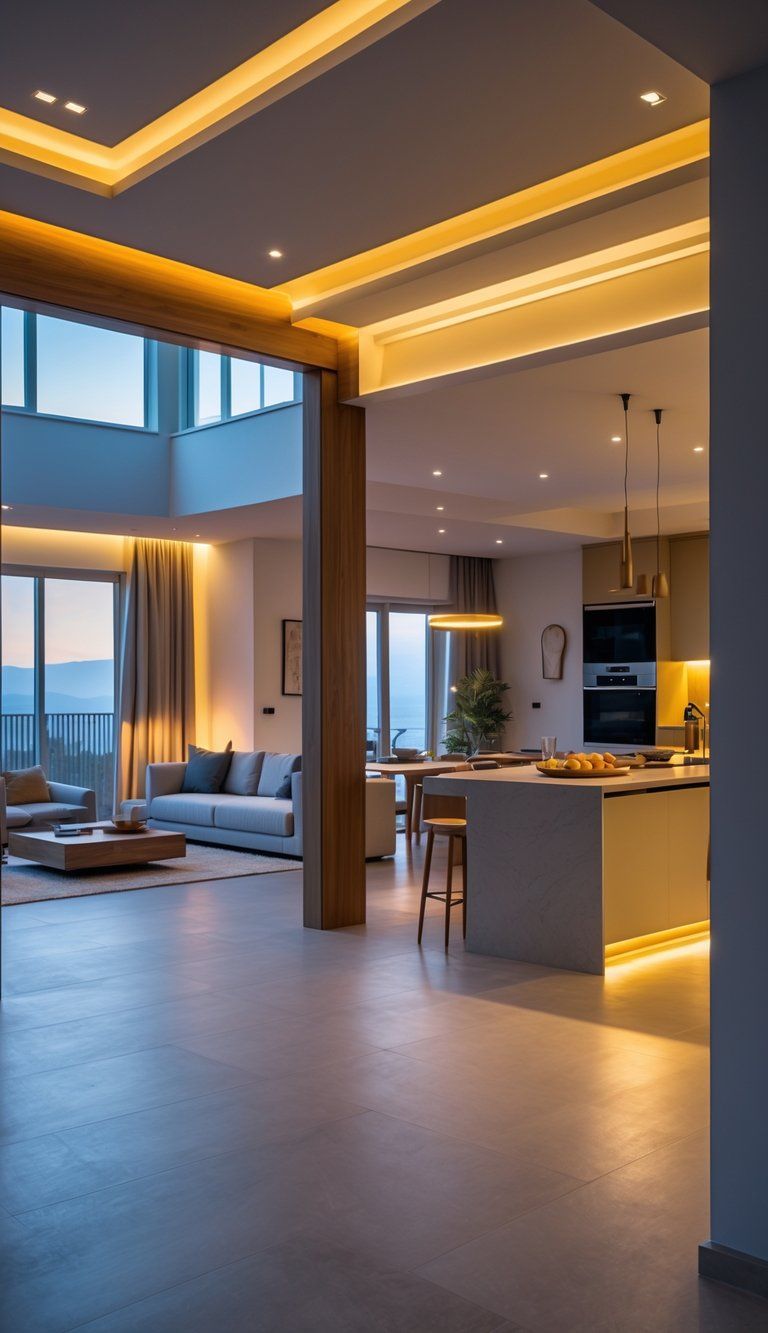
Lighting can totally change how your home feels and flows. It guides your eyes from room to room and helps set a mood that feels consistent but not boring.
Choose your lighting carefully and you’ll link spaces visually, while still letting each room keep its own personality.
Layering Ambient, Task, and Accent Lighting
Think about lighting in layers. Start with ambient lighting—that’s your main source, like overhead fixtures or big ceiling lights. If you stick to similar finishes or styles for these in connected rooms, you’ll get visual harmony.
Next up is task lighting. Use pendants for kitchen islands, desk lamps in your office, or reading lights in the living room—just put the light where you need it.
Accent lighting highlights the cool stuff: artwork, built-ins, or neat architectural features. Wall sconces, track lights, or recessed fixtures do the trick and add some depth.
You’ll get the most flexibility if you put dimmer switches everywhere. That way, you can tweak the brightness as the day goes on and keep the vibe consistent.
Maximizing Natural Light Across Rooms
Natural light instantly connects spaces and makes your home feel more open. Arrange your furniture so sunlight moves deeper into the rooms—don’t block those windows.
If you’re up for a change, maybe knock down a non-load-bearing wall or swap solid doors for glass ones. French doors or even interior windows let light flow while keeping each area separate.
Mirrors work wonders for bouncing sunlight around. Try hanging one opposite a window, or go for glass-topped tables and pale walls to make the most of what you’ve got.
Keep window treatments similar in connected spaces. You don’t need identical curtains, but sticking to related styles, fabrics, or colors helps everything feel more pulled together. Plus, it lets the light filter through in a way that feels intentional.
Architectural Details for Consistency
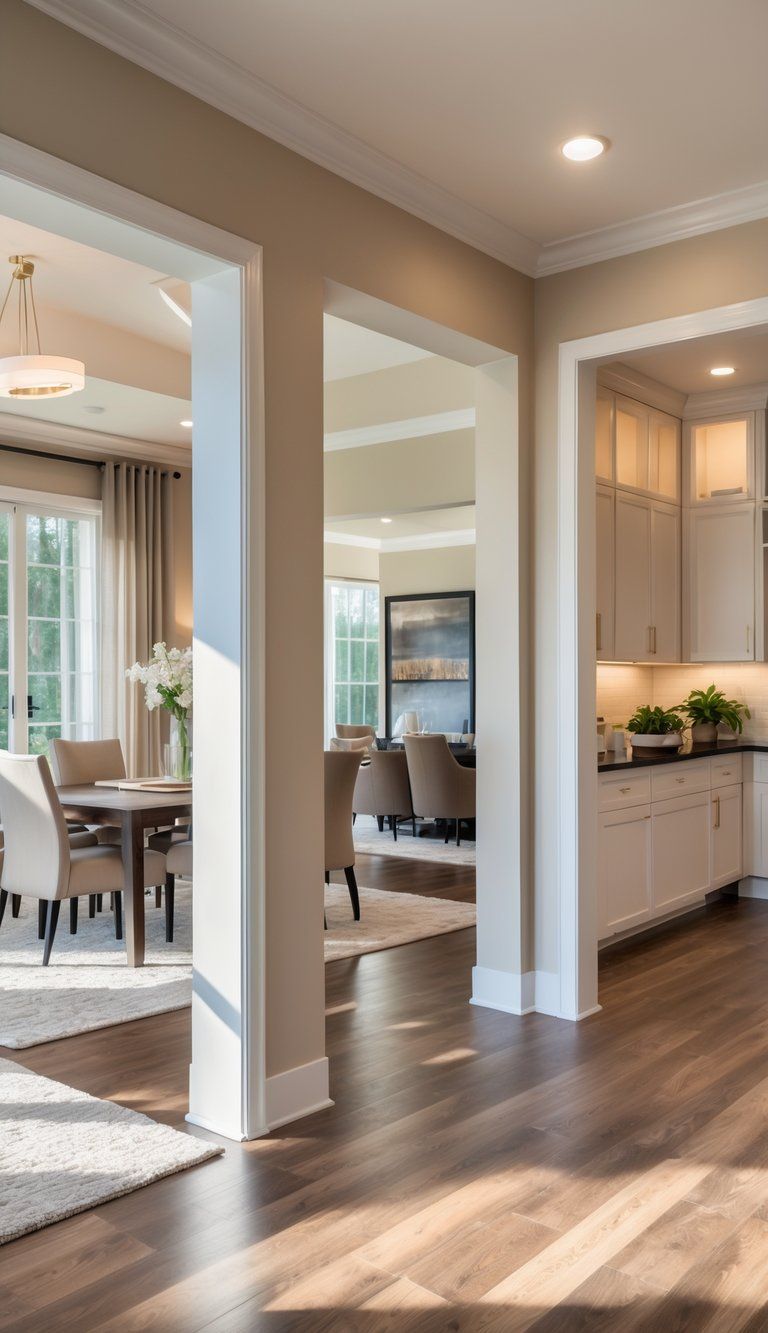
Architectural details might not get all the attention, but they’re what really tie your home together. When you use them consistently, rooms just flow into each other and the whole place feels more put-together.
Using Trim Color and Interior Doors
Trim color works like a thread running through your home. Pick one shade for baseboards, crown molding, and door frames—it’s an instant way to create cohesion. White is classic and flexible, but don’t be afraid of soft grays or even black if you want some drama.
Interior doors are another shot at consistency. Try to standardize:
- Door style (think panels, height)
- Hardware finish (maybe brushed nickel, matte black, or brass)
- Door color (match the trim or go for a contrast)
If you’re swapping out doors, pick a style that fits your home’s vibe. Shaker-style works for transitional spaces, while flat-panel fits modern spots.
You can mix things up by keeping the door style the same but changing colors between floors. For example, white upstairs and black downstairs can still look cohesive if the style matches.
Incorporating Architectural Elements
Repeating certain architectural touches—like archways, built-ins, or wainscoting—brings a nice rhythm to your home. Even if rooms have different purposes, these repeating features help them feel connected.
Window treatments can also add consistency. Try to keep:
- Curtain rod height the same from room to room
- Blind or shade materials similar
- Hardware finishes coordinated
Ceiling details matter too. If you have coffered ceilings, beams, or molding, consider running those through open spaces for a big impact.
If you’re updating an older home, you don’t have to ditch all the character. Maybe swap out dated spindles for sleek metal balusters, but keep the original newel post. You’ll get a mix of old and new that still feels harmonious.
Blending Personal Style With Unified Design
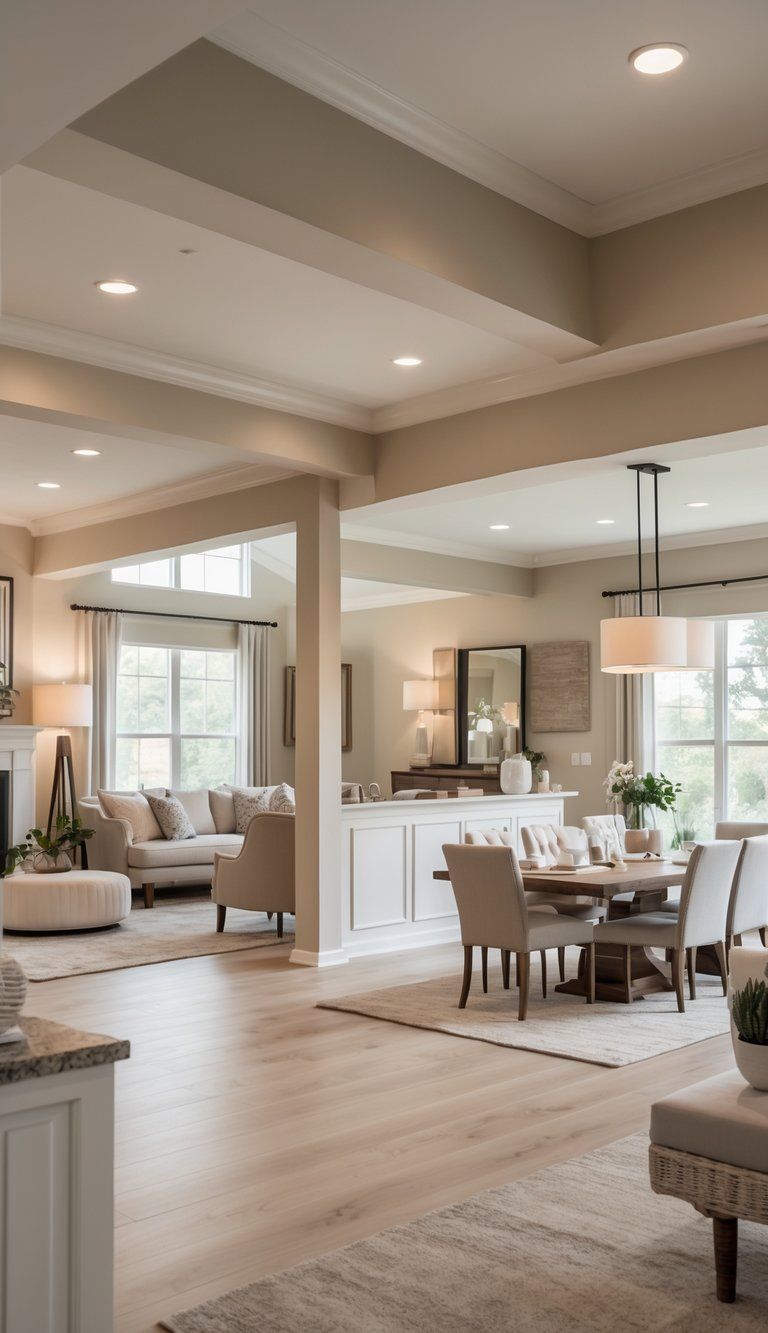
A cohesive home doesn’t mean you have to give up your personality. The best spaces balance what makes you unique with elements that help everything flow.
Infusing Individuality Into a Cohesive Space
Figure out your core interior style first. Maybe you’re into modern, traditional, or something in between—whatever it is, use that as your base. Then, add statement pieces in each room, but keep some consistent threads running through the house.
Color is a great way to unify. Pick 3-5 shades for your whole home, but play with how much of each you use in different rooms. That way, you get both unity and a bit of personality.
Textures work in a similar way. You might have velvet in the living room and linen in the bedroom, but little touches of each material in other rooms tie things together.
Show off what matters to you. Maybe it’s travel souvenirs or family heirlooms—let those be the stars in a room, but balance them with more neutral pieces so nothing feels out of place.
Creating a Mood Board to Guide Design Flow
A mood board is honestly a lifesaver for visualizing your style. Collect images from magazines, Pinterest, or Instagram that just feel right. Add in:
- Furniture you love
- Color combos that catch your eye
- Materials and textures that speak to you
- Lighting that fits your vibe
- Accessories with a personal touch
Lay it all out—digital or old-school, whatever works. You’ll start spotting patterns in what you like.
Tools like Pinterest or Canva make it easy to build and tweak your board. Snap photos of what you already own and see how new finds fit in.
Keep checking your mood board before you buy something new. It helps you stay true to your vision and avoid impulse buys that just don’t work.
Defining Zones and Ensuring Privacy
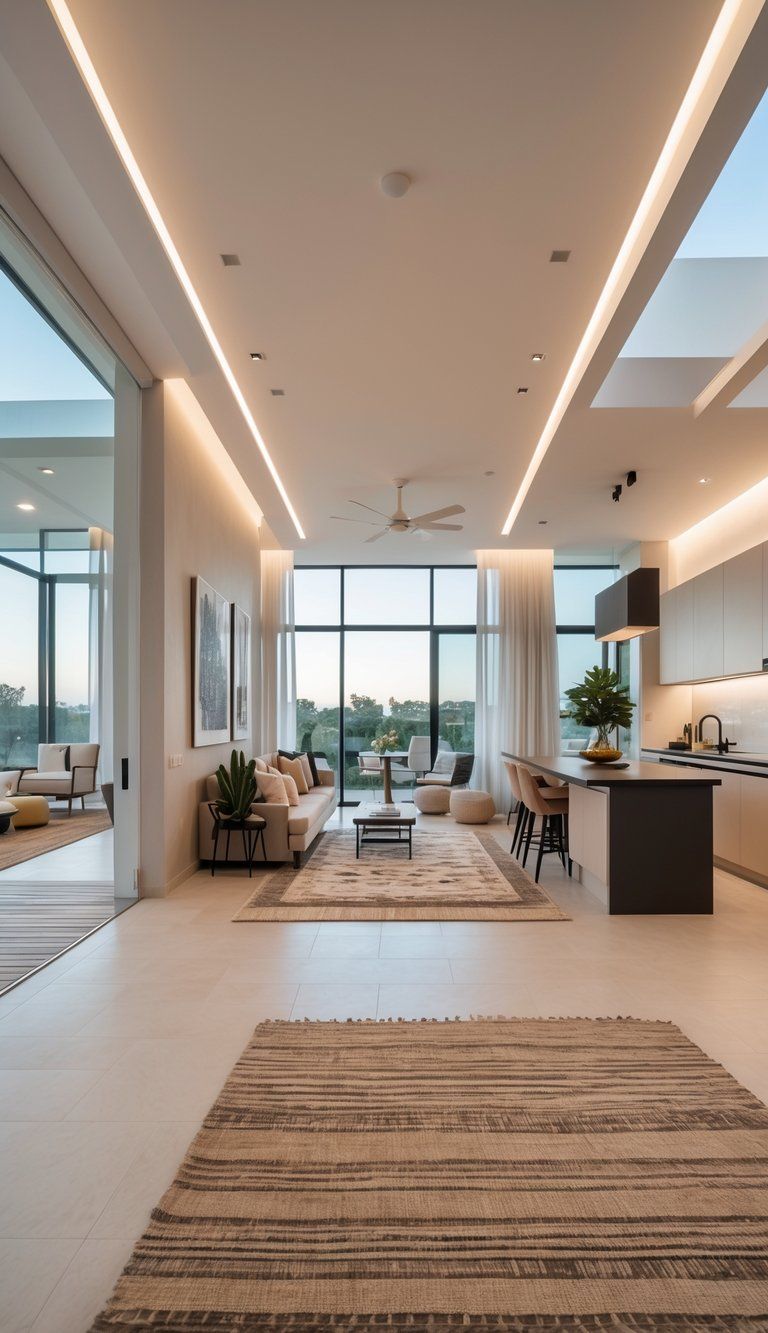
Setting up distinct zones in your home makes it easier for everyone to hang out together or sneak off for some alone time. Clear zones also help your space work better without breaking up that open, connected feel.
Strategies to Define Zones Without Disrupting Flow
Furniture placement is a super simple way to carve out zones. Turn your sofa or chairs so their backs face another area—instantly, you’ve got a new space.
Area rugs do double duty, marking out zones and adding a bit of texture or color. Just make sure the rug size fits the area, with all furniture legs on the rug in a seating zone.
Other ways to define zones:
- Half walls or pony walls for a little separation without blocking light
- Open shelving or bookcases that let you see through but still divide spaces
- Varying ceiling heights to break up big open rooms
- Switching up lighting—like pendants over the dining area, recessed lights in the hallway
Color can help too. Use shades that are related but not identical in nearby zones for a subtle boundary that still feels harmonious.
Balancing Open Plan Living With Privacy Needs
Even in an open-plan home, everyone needs a little privacy now and then. Try creating cozy nooks around the house for reading, working, or just escaping.
A window seat with curtains can be a dreamy reading nook. Tuck a small desk into an alcove for a private workspace.
If you’ve got a multi-generational household, think about:
- Sound-dampening materials between zones
- Sliding or barn doors you can close when you need to
- Well-placed screens or room dividers
- Switching up flooring materials to signal a new area
Privacy isn’t just about what you can see—it’s about sound, too. Rugs, curtains, and upholstered furniture help soak up noise between zones.
When you’re planning, pay attention to sightlines. Arrange furniture so you’re not looking straight into a private spot from the main living area.
Enhancing Cohesion With Natural Elements
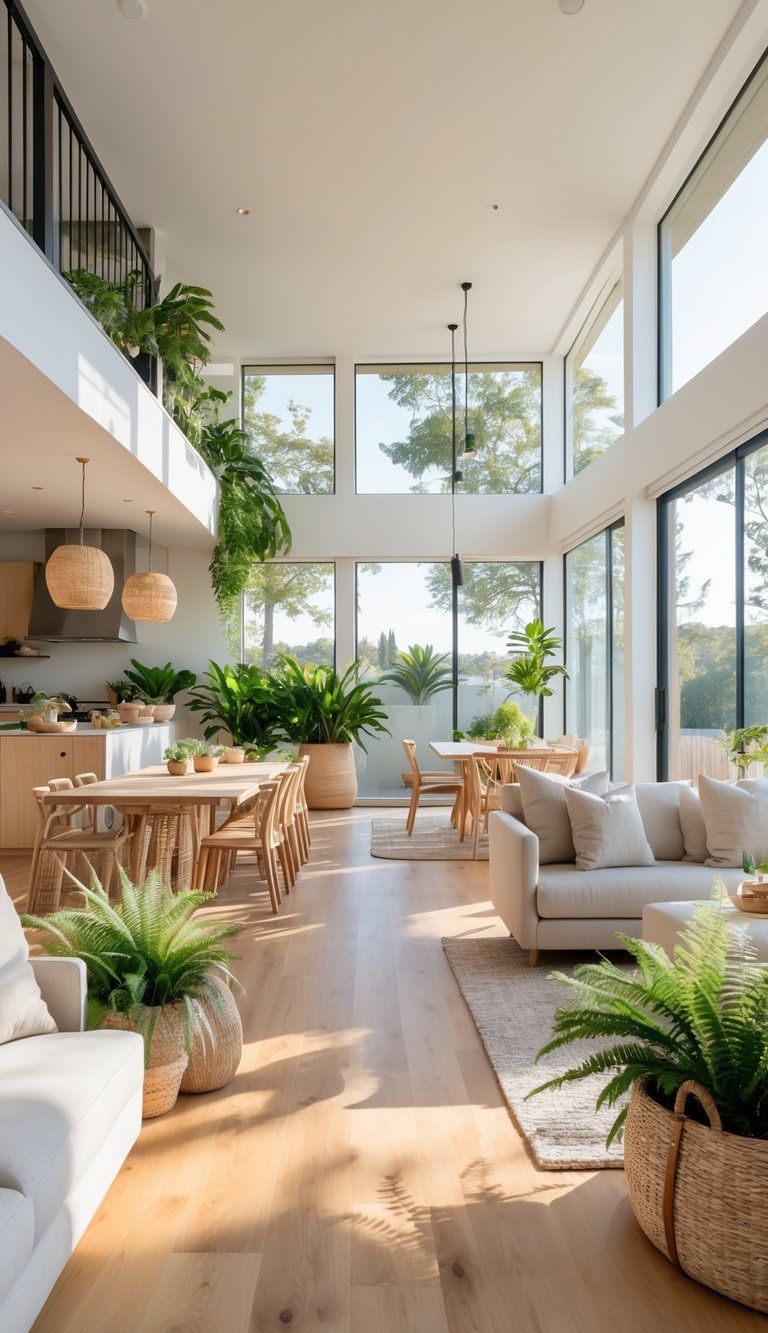
Natural elements can really pull your spaces together and make your home feel both interesting and unified. These organic touches add warmth and help different rooms feel like they belong together.
Bringing the Outdoors In With Materials and Decor
Wood is such a versatile natural element. Use the same wood finish on floors throughout open areas, or pick furniture pieces with similar tones for different rooms.
Stone, like marble or slate, makes a great repeating accent. You might use the same stone for your kitchen counters and bathroom vanity to tie things together.
Natural fibers add a cozy vibe and texture. Think jute rugs, linen curtains, or rattan chairs—they connect spaces without overwhelming the look.
Materials that enhance cohesion:
- Wood (floors, furniture, accent walls)
- Stone (counters, fireplace surrounds, tables)
- Natural fibers (rugs, curtains, baskets)
Using Plants and Organic Textures
Indoor plants instantly help rooms feel connected. Try placing similar plant varieties around your home. Or, if you prefer, stick with the same style of planters in different spaces for a look that feels unified.
Living walls or vertical gardens really make a statement. They also improve air quality, which is a nice bonus. Even a small wall-mounted arrangement can become a focal point and pull rooms together.
Organic textures add depth to your design. You can mix wool throws, cotton pillows, and maybe some leather furniture to create a rich sensory experience. Let those textures flow from one room to the next.
Water features offer a multisensory experience. Small fountains or tabletop water elements can become repeated motifs that please both your eyes and ears.

